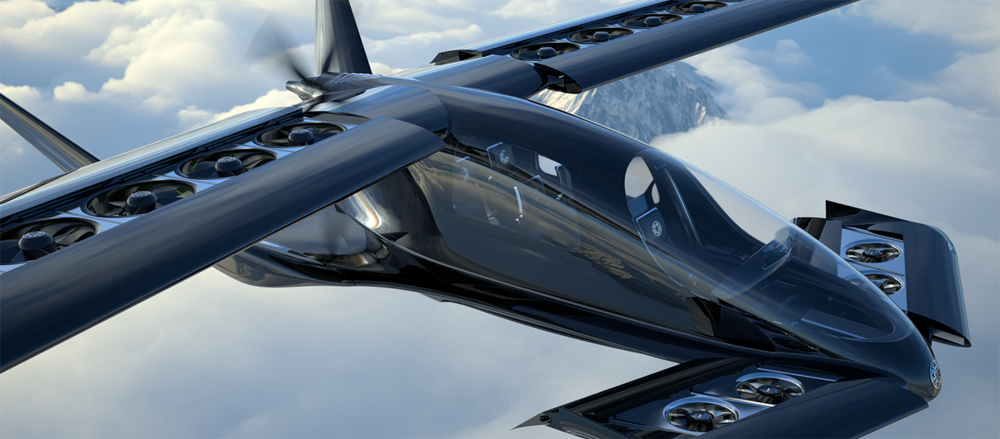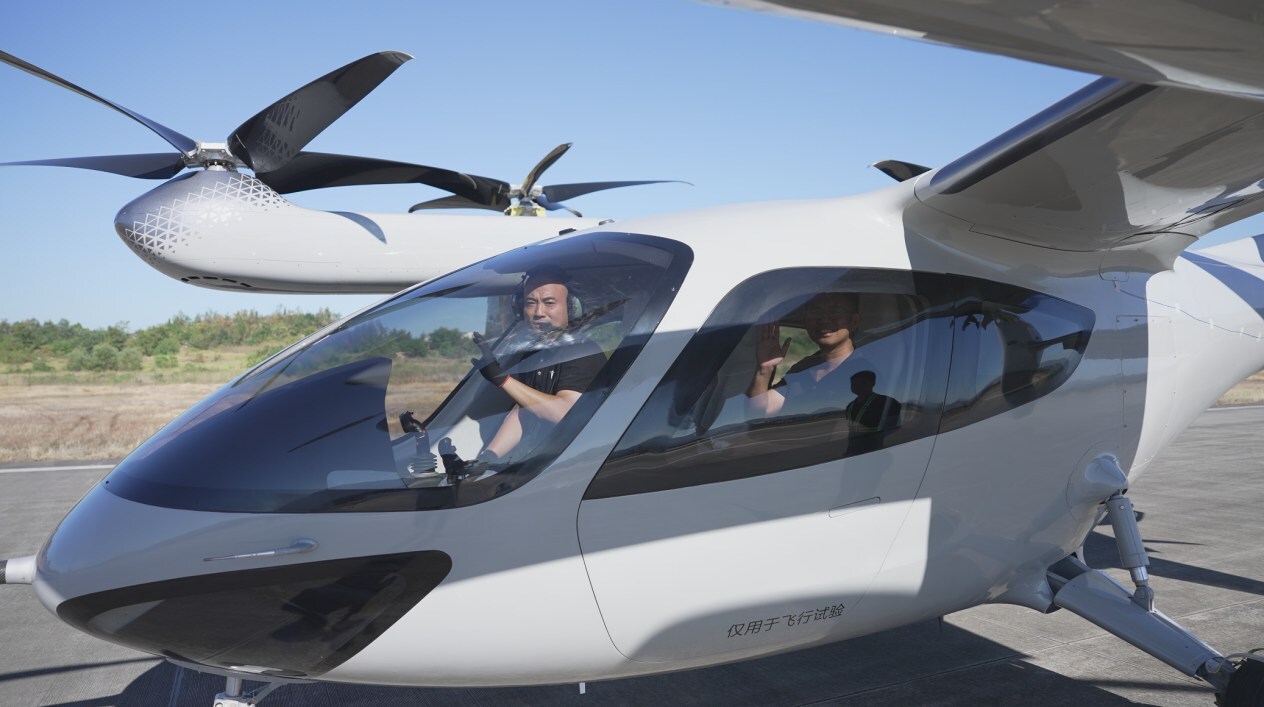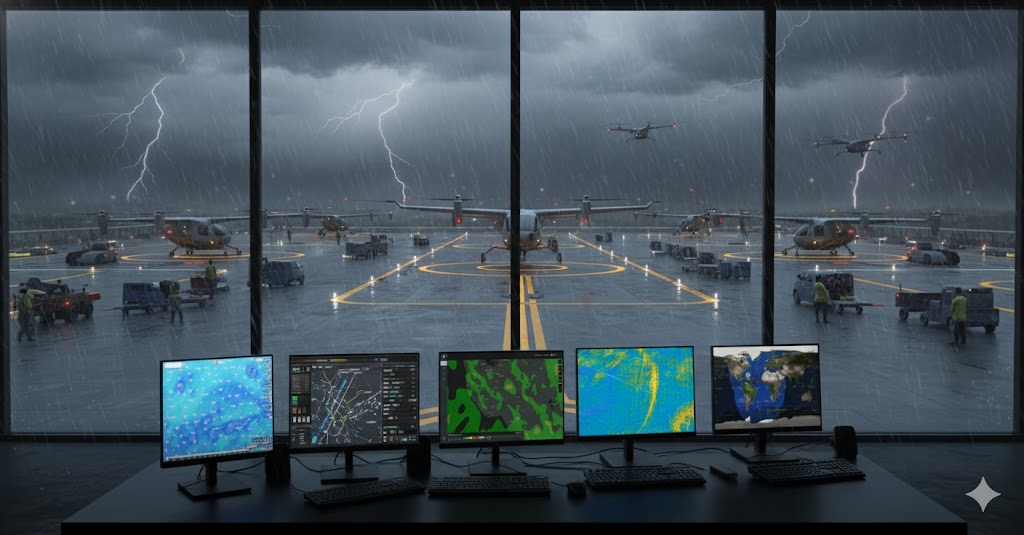On May 15, 2025, Horizon Aircraft achieved a historic milestone in eVTOL aviation technology. Its Cavorite X7 became the world's first eVTOL aircraft to successfully complete a stable wing-borne flight transition using a novel fan-in-wing design, effectively bridging conventional aircraft capabilities with helicopter-like versatility. Unlike competing designs that rely on complex tilt-rotor mechanisms or multiple exposed rotors, the Cavorite X7's innovative approach embeds fans within the wings themselves, creating a system that promises greater efficiency, extended range, and enhanced safety compared to other air mobility solutions currently in development.
The large-scale Cavorite X7 demonstrator completed what the company describes as the world's first stable fan-in-wing transition, effectively shifting from vertical takeoff to conventional forward flight without the complex mechanical challenges that have plagued other eVTOL designs. This transition phase, which involves moving from hover mode to winged flight, represents one of the most technically challenging aspects of eVTOL development and has been a significant hurdle for many competitors in the industry. The achievement places Horizon Aircraft among a very select group of companies worldwide that have successfully demonstrated this capability.
The flight test, conducted on Thursday, May 15, demonstrated the effectiveness of Horizon's patented HOVR wing system, which was specifically engineered to make the transition phase "a non-event" compared to more complex approaches. Brandon Robinson, CEO and co-founder of Horizon Aircraft, highlighted the flight's success on social media, noting that it was "a boring flight, and in flight testing, boring is great," referring to the smooth, uneventful nature of the transition that indicates robust engineering and reliable performance. This stability during the critical transition phase addresses one of the most significant safety concerns in eVTOL development, accelerating the path to certification and commercial deployment.
This achievement validates Horizon's fundamental approach to eVTOL design. Rather than developing an entirely new aircraft configuration, the company has effectively enhanced conventional aircraft architecture with vertical takeoff and landing capabilities. This approach may offer advantages in certification pathways, as the aircraft can be presented to regulators primarily as a conventional aircraft with VTOL capabilities as an additional safety feature rather than as an entirely novel vehicle category. The successful flight also reinforces investor confidence in Horizon Aircraft (NASDAQ: HOVR), positioning the company as a serious contender in the increasingly competitive advanced air mobility market.
Fan-in-Wing System: A Novel Approach to Vertical Flight
The Cavorite X7's most distinctive innovation lies in its patented fan-in-wing design, which differs from the approaches taken by most eVTOL competitors. The aircraft features 14 fans embedded within its airframe-five in each main wing and an additional pair in each forward canard. During vertical takeoff and landing operations, specially designed wing surfaces slide open to expose these battery-powered fans, providing the necessary lift for vertical movement. Once the aircraft achieves sufficient altitude and forward speed, these surfaces smoothly close, transforming the X7 into a conventional fixed-wing configuration for efficient cruising flight. This elegant mechanical solution eliminates the need for complex tilting mechanisms or exposed rotors that characterize many competing designs, reducing points of failure while improving aerodynamic efficiency during forward flight.
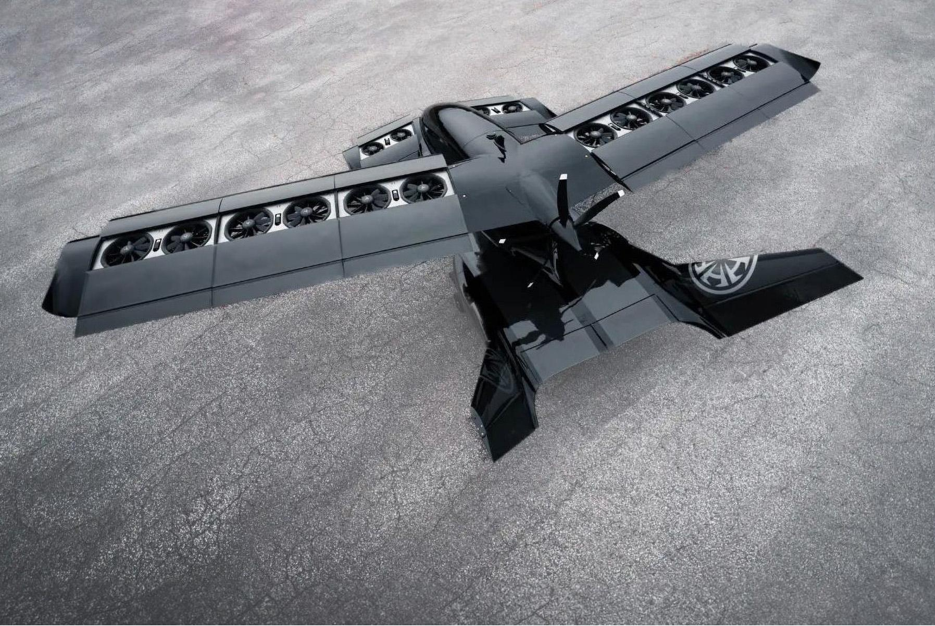
The fan-in-wing system offers numerous advantages beyond mechanical simplicity. When operating in forward flight mode with the fans concealed, the Cavorite X7 benefits from the superior efficiency of conventional winged flight, enabling significantly greater range and speed compared to most eVTOL competitors. The forward-swept wing design isn't merely aesthetic- it serves a critical aerodynamic function by improving handling at low speeds and higher angles of attack, which is essential for smooth transitions between vertical and forward flight modes. This wing configuration allows for enhanced control during the critical transition phase, where the aircraft must gradually shift from powered lift to wing-generated lift without losing altitude or stability.
Hybrid Propulsion: Bridging Current Limitations
The Cavorite X7 employs a sophisticated hybrid-electric propulsion system that combines battery power with a gas turbine engine to overcome the range limitations that impact pure electric aircraft designs. While the embedded fans rely on battery power for vertical takeoff and landing operations, forward flight is primarily powered by a rear-mounted gas turbine engine driving a pusher propeller. This hybrid approach delivers the best of both worlds: the clean, quiet operation of electric propulsion during noise-sensitive takeoff and landing phases, combined with the long-range capability and quick refueling advantages of conventional aircraft during cruise flight. The system represents a pragmatic compromise that addresses current battery technology limitations while providing a pathway to fully electric operation as energy storage technology advances.
One of the Cavorite X7's most innovative features is its ability to recharge its batteries during flight using the gas turbine as an onboard generator. This capability ensures that the aircraft arrives at its destination with fully charged batteries, enabling immediate vertical takeoff capability for the return journey without requiring ground-based charging infrastructure. This in-flight recharging occurs within the first 10-15 minutes of cruise flight, effectively eliminating the extended turnaround times that hamper the operational flexibility of purely electric aircraft. Horizon Aircraft has stated that as battery technology improves, the Cavorite X7 could eventually transition to fully electric operation, making the current hybrid design a forward-thinking approach that accommodates both present limitations and future possibilities.
Technical Specifications and Performance Capabilities
The Cavorite X7 boasts impressive performance specifications that position it advantageously in the competitive advanced air mobility market. With a maximum cruise speed of 288 mph (463 km/h), the aircraft significantly outperforms most competing eVTOL designs, enabling efficient regional connectivity. The X7's range capability is particularly noteworthy, offering approximately 500 miles (800 km) of flight distance with reserves-about five times the range of competitor Archer Aviation's all-electric Midnight eVTOL. This extended range opens possibilities for regional air mobility applications that would be impractical for shorter-range electric designs, potentially filling a crucial market gap between short-hop urban air taxis and conventional commercial aviation.
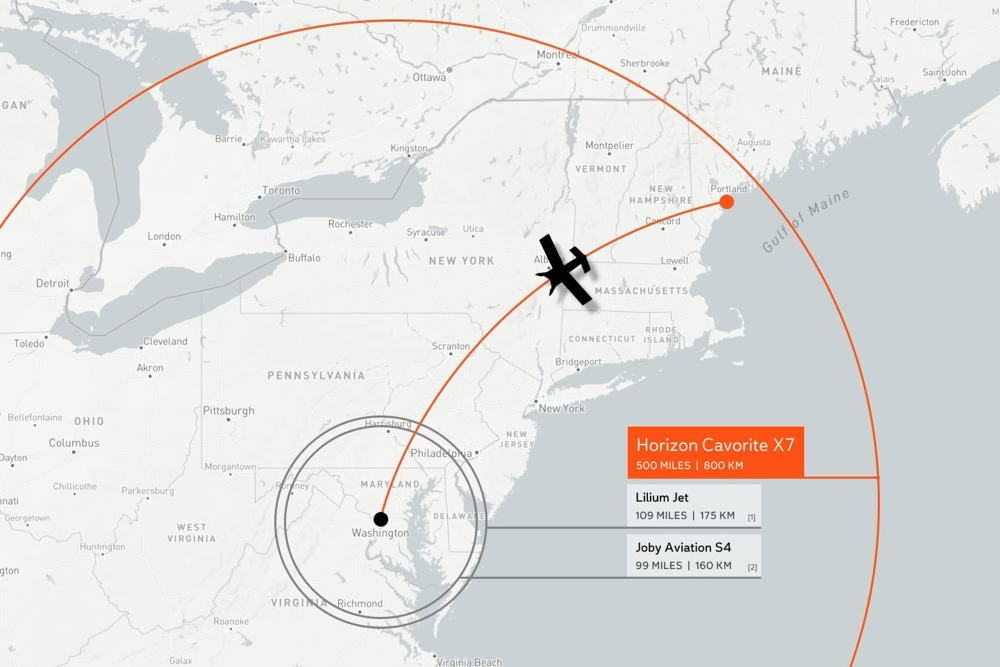
The aircraft's physical dimensions include a 50-foot (15-meter) wingspan and a 38-foot (11.6-meter) fuselage length, making it compatible with existing aviation infrastructure while still offering vertical landing capabilities in space-constrained environments. With a maximum gross weight of 5,500 lbs (2,500 kg), the Cavorite X7 can carry payloads of up to 1,500 lbs (680 kg) for vertical takeoffs or 1,800 lbs (815 kg) when using conventional runway launches. This passenger and cargo capacity allows the aircraft to accommodate six passengers plus a pilot, making it suitable for a wide range of operations, including commercial transport, business aviation, cargo, medical, and specialized operations. Additionally, the X7 features short takeoff and landing (STOL) capability, requiring only about 1,000 feet (305 meters) of runway when operating in conventional flight mode, comparable to popular small aircraft like the Cessna.
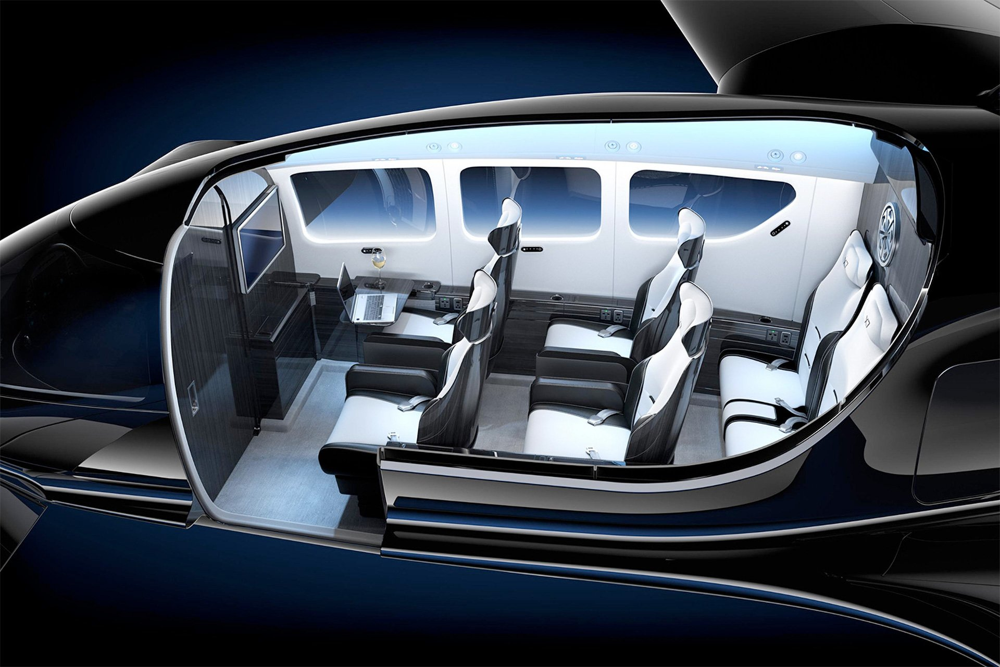
Operational Advantages and Safety Features
When utilizing its vertical takeoff and landing capabilities, the X7 can operate from any suitable landing area sized approximately 1.5 times its overall length, including vertiports, helipads rated H1 to H3, hospital rooftops, yacht decks, and ski resorts. This vertical landing capability eliminates the need for extensive runway infrastructure, enabling point-to-point transportation in areas where conventional aircraft cannot operate. Conversely, operating as a standard fixed-wing aircraft allows the X7 to utilize the existing network of airports and airstrips, providing operational redundancy and flexibility that purely vertical takeoff designs lack. This versatility makes the Cavorite X7 particularly well-suited for mixed operations that combine urban centers with more remote regions lacking extensive aviation infrastructure.
The aircraft arrives at destinations with full battery capacity by recharging its batteries in flight, enabling succeeding flights without time-consuming charging procedures. This quick-turn capability is especially valuable for time-critical applications such as emergency medical services, disaster response, and business travel, where scheduling efficiency directly impacts operational effectiveness. Additionally, the aircraft's ability to operate in both vertical and conventional flight modes provides valuable operational redundancy.
Advanced Safety Features and Redundancies
Safety engineering is at the core of the Cavorite X7 design, with multiple redundancies built into its critical systems. The 14-fan vertical lift system features electrical, thermal, and mechanical isolation between individual fan units, preventing cascading failures that could compromise overall system performance. This high level of redundancy has been demonstrated in flight tests where the unmanned demonstrator successfully maintained stable hover with 30% of its fans disabled, validating the system's fault tolerance. Such redundancy is essential for aircraft certification and public acceptance of new aviation technologies, where safety margins must be demonstrably robust. The distributed electric propulsion approach, with multiple independent lift fans rather than a few larger rotors, inherently provides greater safety through system redundancy for passengers and cargo.
The Cavorite X7 is being designed to meet rigorous certification standards for all-weather operation, including instrument flight rules (IFR) and visual flight rules (VFR) operations, as well as known icing conditions. If certified as planned, it would become the first aircraft in its class to achieve such comprehensive operational ratings. The aircraft's conventional wing-based design also provides inherent safety advantages over pure multicopter configurations, as the wings can generate lift even with reduced or no power, potentially allowing for glide capabilities in emergency scenarios. Operating as either a VTOL aircraft or a conventional fixed-wing aircraft provides an extra layer of operational safety. If vertical landing capabilities are compromised, the aircraft can divert to a suitable runway for a conventional landing. This dual-mode capability builds in a backup landing system that is unavailable for pure VTOL designs.
Environmental and Efficiency Considerations
The Cavorite X7's hybrid design represents a pragmatic approach to environmental sustainability in aviation, offering tangible emissions reductions while maintaining practical operational capabilities. According to Horizon Aircraft, the X7 can operate with up to 30% fewer hydrocarbon emissions than comparable conventional aircraft performing similar operations. This reduction stems primarily from the efficient use of electric propulsion during the vertical takeoff and landing phases, combined with the aerodynamic efficiency of wing-borne cruise flight. While not achieving the zero-emission operation of fully electric aircraft, the X7's hybrid approach offers a more immediate path to emissions reduction that doesn't sacrifice the range and flexibility needed for practical regional operations. This represents a balanced approach to environmental concerns while acknowledging current technological limitations in battery energy density.
The aircraft's wing-based design fundamentally improves energy efficiency during forward flight compared to multicopter or tilt-rotor configurations. Using wings for lift during cruise is far more efficient than relying on powered lift from rotors or fans, resulting in extended range and reduced energy consumption per mile traveled. This efficiency advantage becomes particularly significant on longer routes where cruise flight dominates the mission profile, making the Cavorite X7 especially well-suited for regional connections beyond the urban perimeter. As battery technology continues to evolve and improve, the Cavorite could eventually transition to fully electric operation, making the current hybrid design a forward-compatible approach that accommodates future technological developments.
Market Positioning: Regional Air Mobility and Commercial Transport
The Cavorite X7 is strategically positioned to serve the emerging Regional Air Mobility (RAM) market, potentially transforming transportation between cities and communities separated by distances of 100-500 miles. With its vertical takeoff capability and conventional aircraft speed and range, the X7 could efficiently connect urban centers with suburban and rural communities lacking major airport infrastructure. This regional connectivity represents a distinct market segment from the urban air mobility focus of many competing eVTOL designs, which typically target shorter inner-city routes. The X7's 500-mile range capability opens possibilities for creating regional air networks that could change travel patterns between neighboring cities and regions, providing time-efficient alternatives to both driving and the hassle of commercial aviation for medium-distance travel.
For commercial passenger operations, the Cavorite X7 offers a compelling value proposition through its combination of speed and capacity. With seating for six passengers plus a pilot, the aircraft could serve as executive transport, regional air taxi services, and scheduled regional connections. Horizon Aircraft suggests that the X7 could offer up to 30% lower direct operating costs than a helicopter performing similar regional transport missions while traveling at almost twice the speed, potentially making regional air service economically viable in markets where helicopter operations have proven prohibitively expensive. The aircraft's ability to operate from both conventional airports and vertical landing sites would allow operators to build flexible route networks that combine the convenience of downtown-to-downtown service with the established infrastructure of regional airports, creating a versatile transportation ecosystem beyond what either helicopters or conventional aircraft can individually provide.
Emergency Services and Military and Special Operations Potential
The Cavorite X7's unique capabilities make it well-suited for emergency medical services, disaster response, and humanitarian operations. With its vertical takeoff and landing capability combined with helicopter-exceeding speed, the X7 could transport critically ill or injured patients to advanced care facilities nearly twice as fast as traditional helicopters, potentially saving lives in time-critical medical emergencies. The aircraft's 500-mile range would enable direct patient transfers between regional medical centers without refueling stops, expanding the effective service radius of specialized care facilities and improving access to advanced medical services for remote communities. Additionally, the X7's all-weather capability, including operation in known icing conditions, would enable more consistent emergency response regardless of weather conditions that might ground less capable aircraft.

For disaster relief and humanitarian operations, the Cavorite X7 offers valuable capabilities for rapid response and sustained support. The aircraft's ability to vertically land in areas with damaged infrastructure, combined with its 1,500-pound payload capacity in vertical takeoff mode, would enable the delivery of critical supplies to disaster-affected areas without requiring functional runways or prepared landing sites. The X7's hybrid propulsion system, which doesn't rely on ground-based charging infrastructure, would be particularly valuable in disaster scenarios where electricity may be unavailable or unreliable. Meanwhile, the extended range capability would allow operations from distant staging areas, potentially reducing logistical complexity by eliminating the need for forward operating bases in challenging environments.
The Cavorite X7 has attracted attention for its potential military applications, particularly in situations requiring a combination of vertical access, speed, range, and reduced acoustic signature. The aircraft was selected for the competitive AFWERX High-Speed VTOL (HSVTOL) Challenge, a program developed in partnership with the United States Air Force and US Special Operations Command to explore innovative high-speed vertical takeoff and landing concepts. Military applications could include reconnaissance, medical evacuation, troop insertion/extraction, and intelligence, surveillance, and reconnaissance (ISR) missions, with the X7's fan-in-wing technology providing a low acoustic signature that enhances stealth capabilities for sensitive operations. This reduced noise profile, combined with the ability to operate without prepared landing areas, makes the X7 particularly suitable for special operations requiring discreet insertion and extraction of personnel.
Development Roadmap and Certification Path
Following the successful transition flight of the large-scale demonstrator, Horizon Aircraft is now advancing to the next phase of development with the construction of a full-scale, piloted technical demonstrator. This progression represents a significant step toward eventual type certification and commercial production, though the company has not publicly disclosed a specific timeline for these milestones. The certification strategy appears to leverage the X7's conventional aircraft characteristics, with CEO Brandon Robinson previously noting that the company could approach FAA regulators with the argument that "this is a normal airplane" where the VTOL capability represents "just a layer of safety on top," potentially simplifying the certification process compared to more unconventional eVTOL designs. This approach may prove advantageous in navigating the evolving regulatory framework for advanced air mobility aircraft, where certification pathways for novel configurations remain under development.
The company's carefully staged development approach, moving from subscale testing to the current large-scale demonstrator and then to a full-scale prototype, reflects a methodical risk reduction strategy typical of successful aerospace programs. This graduated testing regimen allows for the identification and resolution of technical challenges before committing to full-scale production, potentially reducing development costs and certification timelines. Horizon's public statements suggest that the company's immediate focus will be on proving the X7's capabilities on the full-scale demonstrator before scaling up production to meet anticipated demand from various market segments, including regional operators, emergency service providers, and military customers. This staged approach demonstrates a practical recognition of the technical and regulatory hurdles remaining before commercial operations can begin, while still maintaining momentum toward eventual market entry.
Competitive Positioning and Market Impact
The Cavorite X7's successful transition flight establishes Horizon Aircraft as a serious contender in the increasingly competitive advanced air mobility sector. The X7's hybrid approach and conventional aircraft architecture differentiate it from many competitors focused on purely electric multicopter or tilt-rotor designs, potentially appealing to operators prioritizing range, speed, and all-weather capability over zero-emission operation. The comparison with other leading eVTOL manufacturers highlights the X7's distinctive value proposition-offering approximately five times the range of Archer Aviation's all-electric Midnight eVTOL and significant speed advantages over many competitors, albeit with the tradeoff of continued partial reliance on fossil fuels.
The industry's response to Horizon Cavorite X7 includes competitive developments, such as UK-based Vertical Aerospace's recent announcement that it would also develop a hybrid version of its VX4 eVTOL aircraft. This parallel move toward hybrid solutions by another established player suggests growing recognition of the practical limitations of purely electric designs for certain mission profiles, particularly those requiring extended range. The increasing industry interest in hybrid approaches validates Horizon's early commitment to this technology pathway and may accelerate market acceptance of such solutions as pragmatic interim steps toward eventual full electrification.
Hybrid-Electric VTOL Contenders
Ascendance Flight Technologies ATEA
The ATEA hybrid-electric VTOL, developed by Airbus alumni, combines a fan-in-wing design with a modular hybrid engine system. Its eight vertical lift fans are embedded in the wings, while two forward-flight propellers on the nose and tail enable efficient cruise. With a range of 400 km (249 miles) and a cruise speed of 200 km/h (124 mph), the ATEA targets urban and regional routes, emphasizing reduced noise (four times quieter than helicopters) and 80% lower emissions. Unlike the Cavorite X7, which uses a gas turbine for mid-flight battery charging, the ATEA relies on a kerosene-battery hybrid system, though it plans to transition to hydrogen or sustainable aviation fuel (SAF). Scheduled for production in 2025, the ATEA’s five-seat capacity and focus on urban air mobility (UAM) applications position it as a direct competitor for short-haul markets.
Vertical Aerospace VX4 Hybrid
Vertical Aerospace’s VX4 Hybrid represents a strategic expansion of its all-electric platform, targeting a staggering 1,000-mile range-double the Cavorite X7’s 500-mile capability. Designed for defense and logistics, the hybrid variant retrofits a gas turbine range extender into the existing VX4 airframe, enabling payloads up to 1,100 kg. While the X7 prioritizes passenger transport, Vertical’s focus on military and cargo applications highlights divergent market strategies. The VX4 Hybrid’s flight testing is slated for 2026, with certification expected by 2028. Its emphasis on low acoustic/thermal signatures and redundant systems mirrors the X7’s safety-first approach, but its larger airframe and extended range could appeal to operators requiring heavy-lift capabilities.
AltoVolo Sigma
AltoVolo’s Sigma hybrid eVTOL targets the private aviation sector with a 510-mile range and a cruise speed of 220 mph, closely matching the X7’s performance. However, its three-seat capacity limits it to niche markets compared to the X7’s six-passenger configuration. The Sigma emphasizes noise reduction (80% quieter than helicopters) and rapid turnaround times, aligning with urban air taxi demands7. While both aircraft use hybrid systems, the Sigma’s smaller size and focus on luxury travel differentiate it from the X7’s regional mobility mission.
Hydrogen-Electric and Alternative Propulsion Competitors
Stellar Aircraft Jet
Stellar’s hydrogen-electric VTOL jet redefines long-range sustainability with a 1,150-mile range, over twice the X7’s capability, powered by solid-state hydrogen storage and ducted fans. Its pressurized cabin and 323 mph cruise speed cater to high-altitude regional travel, targeting business aviation and emergency services. While the X7’s hybrid system offers operational flexibility, Stellar’s zero-carbon hydrogen propulsion appeals to environmentally conscious operators. However, hydrogen infrastructure limitations and a $8.9 million base price could constrain adoption compared to the X7’s hybrid model.
Honda Hybrid eVTOL
Honda’s hybrid eVTOL leverages gas turbine technology from its HondaJet lineage, targeting a 400 km (249-mile) range with a focus on inter-city travel. The system combines a high-RPM gas turbine generator with batteries, charging during cruise for vertical landing reserves. While shorter-ranged than the X7, Honda’s emphasis on certification experience and SAF compatibility positions it as a reliable contender for Japanese and North American markets. The X7’s STOL capability and higher passenger capacity give it an edge in versatility.
Innovative Design Approaches
Zuri Hybrid VTOL
Zuri’s hybrid system prioritizes efficiency using sustainable aviation fuel (SAF), claiming 5x greater energy density than batteries and a 700 km usable range. Its flap-based thrust vectoring eliminates tilting mechanisms, simplifying transition aerodynamics, a challenge the X7 addresses with sliding wing panels. Zuri’s focus on low emissions (136 g CO₂/kWh vs. 275 g/kWh for grid-charged eVTOLs) appeals to eco-conscious operators, though its larger size and cargo focus differ from the X7’s passenger-centric design.
Cyclocar Cyclic Propulsion
Russia’s Cyclocar employs a novel cyclic propulsion system with rotating barrels for 360° thrust vectoring, enabling a 500 km range and six-passenger capacity. Its hybrid-electric powertrain and compact design suit military and urban logistics, but the unconventional mechanics pose certification hurdles compared to the X7’s fan-in-wing simplicity.
Conclusion
As Horizon Aircraft advances toward full-scale demonstration and eventual certification, the Cavorite X7 could play a transformative role in multiple markets, from regional air mobility connecting underserved communities to emergency medical services, delivering faster patient transport, and military operations requiring discreet vertical access capabilities. The aircraft's unique combination of vertical takeoff capability, extended range, and high speed addresses practical limitations that have historically confined vertical lift aircraft to niche applications, potentially expanding the practical utility of VTOL technology to mainstream transportation roles.
The aviation industry will be watching closely as Horizon Aircraft continues development toward commercial production, with particular attention to how the X7's innovative fan-in-wing system performs in full-scale testing across various operational conditions. The historic first transition flight of the Cavorite X7 may ultimately be remembered not just as a technical milestone but as a pivotal moment in the evolution of practical vertical flight technology with far-reaching implications for the future of regional transportation.
